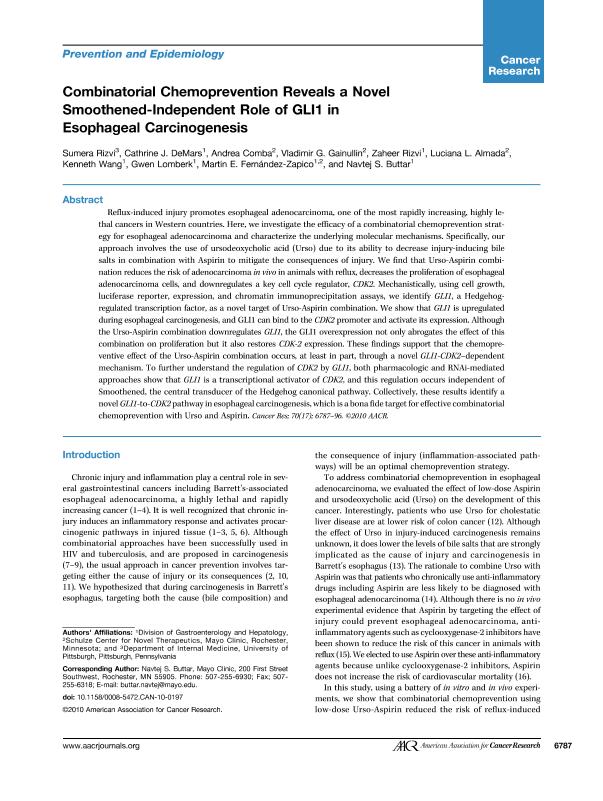Mostrar el registro sencillo del ítem
dc.contributor.author
Rizvi, Sumera
dc.contributor.author
DeMars, Cathrine J.
dc.contributor.author
Comba, Andrea

dc.contributor.author
Gainullin, Vladimir G.
dc.contributor.author
Rizvi, Zaheer
dc.contributor.author
Almada, Luciana L.
dc.contributor.author
Wang, Kenneth
dc.contributor.author
Lomberk, Gwen
dc.contributor.author
Fernández-Zapico, Martin E.
dc.contributor.author
Buttar, Navtej S.
dc.date.available
2023-02-22T09:44:33Z
dc.date.issued
2010-09-01
dc.identifier.citation
Rizvi, Sumera; DeMars, Cathrine J.; Comba, Andrea; Gainullin, Vladimir G.; Rizvi, Zaheer; et al.; Combinatorial chemoprevention reveals a novel smoothened-independent role of GLI1 in esophageal carcinogenesis; American Association for Cancer Research; Cancer Research; 70; 17; 1-9-2010; 6787-6796
dc.identifier.issn
0008-5472
dc.identifier.uri
http://hdl.handle.net/11336/188501
dc.description.abstract
Reflux-induced injury promotes esophageal adenocarcinoma, one of the most rapidly increasing, highly lethal cancers in Western countries. Here, we investigate the efficacy of a combinatorial chemoprevention strategy for esophageal adenocarcinoma and characterize the underlying molecular mechanisms. Specifically, our approach involves the use of ursodeoxycholic acid (Urso) due to its ability to decrease injury-inducing bile salts in combination with Aspirin to mitigate the consequences of injury. We find that Urso-Aspirin combination reduces the risk of adenocarcinoma in vivo in animals with reflux, decreases the proliferation of esophageal adenocarcinoma cells, and downregulates a key cell cycle regulator, CDK2. Mechanistically, using cell growth, luciferase reporter, expression, and chromatin immunoprecipitation assays, we identify GLI1, a Hedgehogregulated transcription factor, as a novel target of Urso-Aspirin combination. We show that GLI1 is upregulated during esophageal carcinogenesis, and GLI1 can bind to the CDK2 promoter and activate its expression. Although the Urso-Aspirin combination downregulates GLI1, the GLI1 overexpression not only abrogates the effect of this combination on proliferation but it also restores CDK-2 expression. These findings support that the chemopreventive effect of the Urso-Aspirin combination occurs, at least in part, through a novel GLI1-CDK2-dependent mechanism. To further understand the regulation of CDK2 by GLI1, both pharmacologic and RNAi-mediated approaches show that GLI1 is a transcriptional activator of CDK2, and this regulation occurs independent of Smoothened, the central transducer of the Hedgehog canonical pathway. Collectively, these results identify a novel GLI1-to-CDK2 pathway in esophageal carcinogenesis, which is a bona fide target for effective combinatorial chemoprevention with Urso and Aspirin.
dc.format
application/pdf
dc.language.iso
eng
dc.publisher
American Association for Cancer Research

dc.rights
info:eu-repo/semantics/openAccess
dc.rights.uri
https://creativecommons.org/licenses/by-nc-sa/2.5/ar/
dc.subject
GLI1
dc.subject
Hedgehog signaling
dc.subject
Chemoprevention
dc.subject
Esophageal adenocarcinoma
dc.subject.classification
Bioquímica y Biología Molecular

dc.subject.classification
Medicina Básica

dc.subject.classification
CIENCIAS MÉDICAS Y DE LA SALUD

dc.title
Combinatorial chemoprevention reveals a novel smoothened-independent role of GLI1 in esophageal carcinogenesis
dc.type
info:eu-repo/semantics/article
dc.type
info:ar-repo/semantics/artículo
dc.type
info:eu-repo/semantics/publishedVersion
dc.date.updated
2023-02-07T11:52:47Z
dc.identifier.eissn
1538-7445
dc.journal.volume
70
dc.journal.number
17
dc.journal.pagination
6787-6796
dc.journal.pais
Estados Unidos

dc.journal.ciudad
Philadelphia
dc.description.fil
Fil: Rizvi, Sumera. Mayo Clinic Cancer Center; Estados Unidos. University of Pittsburgh; Estados Unidos
dc.description.fil
Fil: DeMars, Cathrine J.. Mayo Clinic Cancer Center; Estados Unidos. University of Pittsburgh; Estados Unidos
dc.description.fil
Fil: Comba, Andrea. Mayo Clinic Cancer Center; Estados Unidos. University of Pittsburgh; Estados Unidos. Consejo Nacional de Investigaciones Científicas y Técnicas. Centro Científico Tecnológico Conicet - Córdoba; Argentina
dc.description.fil
Fil: Gainullin, Vladimir G.. Mayo Clinic Cancer Center; Estados Unidos. University of Pittsburgh; Estados Unidos
dc.description.fil
Fil: Rizvi, Zaheer. Mayo Clinic Cancer Center; Estados Unidos. University of Pittsburgh; Estados Unidos
dc.description.fil
Fil: Almada, Luciana L.. Mayo Clinic Cancer Center; Estados Unidos. University of Pittsburgh; Estados Unidos
dc.description.fil
Fil: Wang, Kenneth. Mayo Clinic Cancer Center; Estados Unidos. University of Pittsburgh; Estados Unidos
dc.description.fil
Fil: Lomberk, Gwen. Mayo Clinic Cancer Center; Estados Unidos. University of Pittsburgh; Estados Unidos
dc.description.fil
Fil: Fernández-Zapico, Martin E.. Mayo Clinic Cancer Center; Estados Unidos. University of Pittsburgh; Estados Unidos
dc.description.fil
Fil: Buttar, Navtej S.. Mayo Clinic Cancer Center; Estados Unidos. University of Pittsburgh; Estados Unidos
dc.journal.title
Cancer Research

dc.relation.alternativeid
info:eu-repo/semantics/altIdentifier/url/http://cancerres.aacrjournals.org/content/70/17/6787.long
dc.relation.alternativeid
info:eu-repo/semantics/altIdentifier/doi/https://doi.org/10.1158/0008-5472.CAN-10-0197
Archivos asociados
